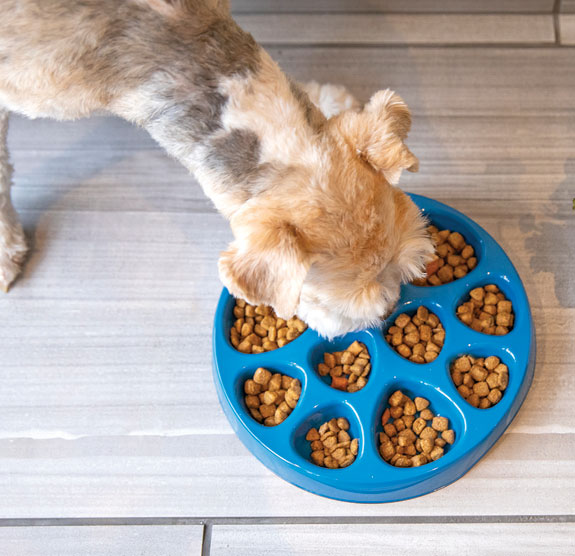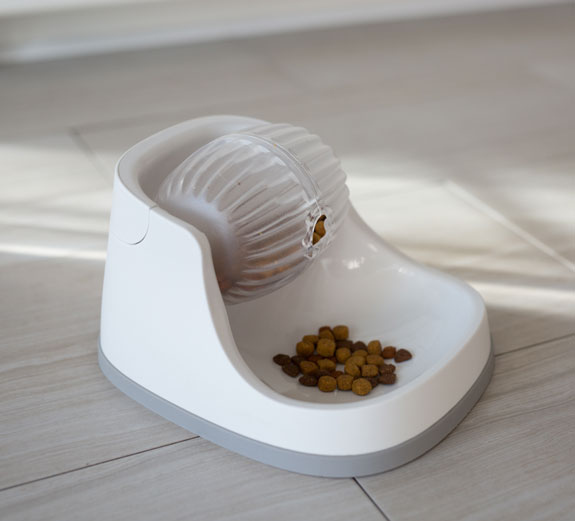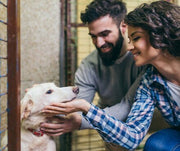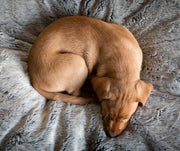Dangers of Your Dog Inhaling Their Food & How To Stop It

Humans often have a hard time with portion control when it comes to feeding ourselves. It can be difficult when there are happy meals, combo meals, or even Taco Tuesdays at every corner. Fast food marketing is very influential in our daily lives and can cause us to struggle with eating healthy amounts. Believe it or not, our pets can have the same problem too. They may get a little too excited for mealtime and may eay all their food without chewing! Or they may get into their stash of food when you're not home. Or, you may unknowingly be giving your pet too much food. While we might think we are wonderful at feeding our pups, here are a few thing you should be aware of when it comes to feeding your dog and giving them a happy and healthy life.
IS MY DOG FIT?
One of the first steps in assessing your dog's food portion amount is to figure out if they are in good shape. One of the easiest ways to tell if your dog is fit is to run your hands down the sides of your dog's body. You should be able to easily feel his ribs, but not see them. This means your dog is a healthy size and is not obese. If you are still uncertain about your dog's weight and health, the most reliable thing you can do is take him to the vet for a checkup. While you're there, ask the vet about your pet's weight. If the vet gives you a thumbs up, you can keep feeding your pet the normal and recommended amount that is on the back of your pet's food bag. If your vet tells you your pet needs to lose weight, you will have to put your pet on the vet's recommended diet.
If your vet recommends a diet with strict portion control, one of the best things you can purchase for your dog is an automatic feeder. These devices will allow you to set the exact amount of food you want your dog to eat and when you want them to eat it. This will relieve you from the task of remembering to feed them on time and with the exact amount they need. The Gamma2 Nano is a great option and helps ensure that you are not overfeeding or underfeeding your dog.
Besides overfeeding your dog, these are other ways that your dog could become obese or unhealthy. Sometimes, dogs eat their food way too fast without chewing, which can cause bloating, discomfort, gas, or even regurgitating their food. Eating too fast can then lead to other, more serious health problems. Keep reading to understand the dangers that can be caused by your dog inhaling their food and ways to slow your dog down while he eats.
THE DANGERS OF INHALING FOOD
To put it simply, there are many dangers caused by dogs inhaling their food. Some can even be fatal. The dangers include:
- choking
- bloating
- twisted stomach
- gastric dilation and volvulus
Some of these terms may be confusing if you've never heard of them. But all in all, when you dog inhales his food, he can choke on it and block the air from getting to his lungs. This is a big danger. If he starts chowing down on his food too fast, he can also become bloated, which could lead to discomfort. If your dog inhales his food without chewing it up first, he can end up getting Gastric Dilation Volvulus (GDV). GDV is when a dog becomes bloated due to too much-unchewed food, air, froth, or gas. When this happens, your dog's stomach can flip, which closes off both entry and exit points to the dog's stomach. Once it has flipped, the stomach will begin to ferment due to the fact that it cannot discard its contents because of the twisting. This will then push up against all the vital organs and cause the dog great difficulty in breathing, which can lead to death.
SYMPTOMS OF GASTRIC DILATION VOLVULUS:
- restlessness
- anxiety
- discomfort or pain
- arched back and reluctant to lie down
- drooling saliva or froth
- swollen abdomen
- dry heaving
- shock
- pale-colored gums and tongue
- rapid breathing
If you know your dog inhales his food without chewing and is displaying any of these symptoms, take him to the vet immediately. He will likely need immediate surgery.
HOW TO MAKE MY DOG SLOW DOWN AND CHEW HIS FOOD

If your dog inhales his food, you need to make sure that you take control of the situation right away. Slowing down and chewing his food will significantly improve his digestion, provide less bloating, less gas, less choking and regurgitation of food, and overall better gut health. One of the easiest ways to slow down your dog's eating and make him chew his food is with a Slow Feeder.
Slow Feeder Dog Bowls are engineered in a way to provide obstacles and make your dog slow down to chew their food when they eat. Sometimes referred to as Puzzle Bowls, slow feeders come in a variety of designs and challenges. Some have raised walls in the center of the bowl, some are made up of several compartments that each holds different amounts of food.

You must pay attention to your dog when you first give him a slow feed bowl. Some designs may be a little too hard for your dog to figure out, which could cause your dog to lose interest in his food. You may have to encourage your dog to work for their food at first. Also, pay attention to your dog's snout after he's eaten from his slow-feed bowl a couple of times. If your dog's snout is too long or wide, they could end up rubbing it raw on the raised walls. If this happens, you'll need to find another design. Slow-feeder bowls not only make mealtime last longer, but they are also mentally stimulating and will help with your dog's brain development.
CONCLUSION
Inhaling dog food can be quite dangerous. But it is so easy to discourage and train your dog to eat slower. With a few simple tools, you can dismiss the worry about the dangers of fast eating and obesity. You are in control of your dog's health and happiness. So, be sure to make sure you provide your dog with the best tools so that they can grow to live a happy and healthy life.
Sources:
Previous article

Related posts
View all-

Keep Your Pets Safe During the Holidays
The holiday season brings joy, festivities, and a break from the usual routine. While you're enjoying the celebrations, it's important to remember that the holidays can present unique challenges for our furry family members. The new sights, sounds, and people can be overwhelming, and common festive items can pose unexpected risks.
Read Article -

Holiday Gifts for Every Pet Personality: The Ultimate Guide
The holiday season is finally here, and for many of us, that means finding the perfect presents for the ones we love most—our pets. Whether they are a steadfast dog who never leaves your side or an independent cat who graces you with their presence on their own terms, our pets are cherished members of the family. They deserve to celebrate right alongside us, stocking stuffers and all.
Read Article -

How to Keep Your Pet Calm During Thanksgiving
Thanksgiving is a time for family, friends, and food, but for our pets, the holiday can be overwhelming. The sudden change in routine, unfamiliar faces and scents, and increased noise can trigger significant stress. Understanding why your pet might feel anxious is the first step toward creating a peaceful holiday experience for everyone, including your furry family members. This guide offers calming tips for pets and practical solutions to ensure your dog or cat feels safe and secure during the festivities.
Read Article




